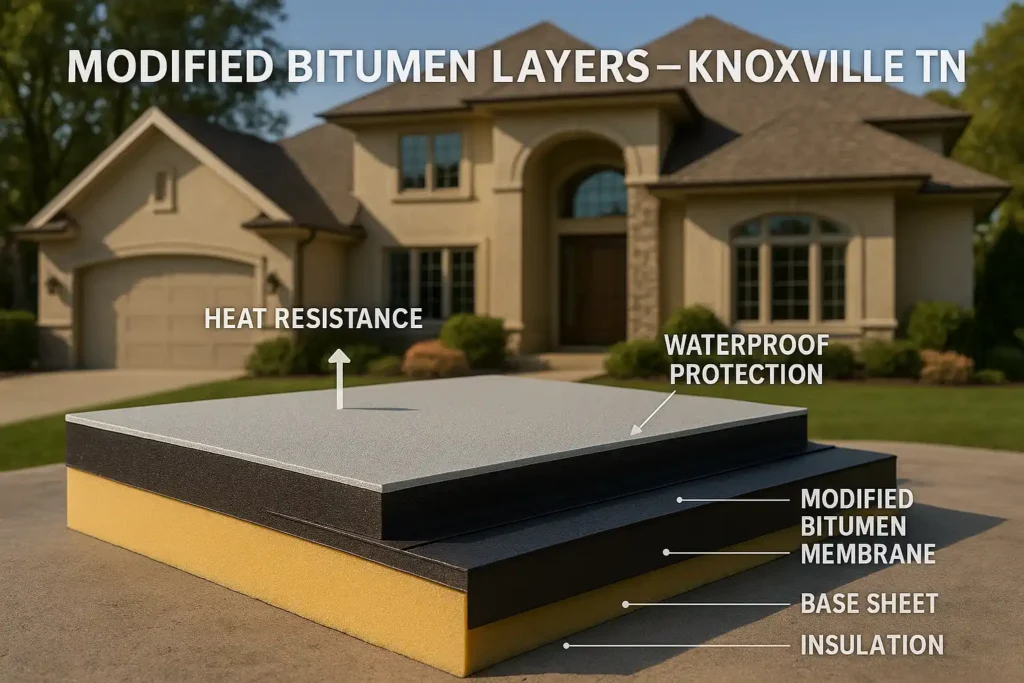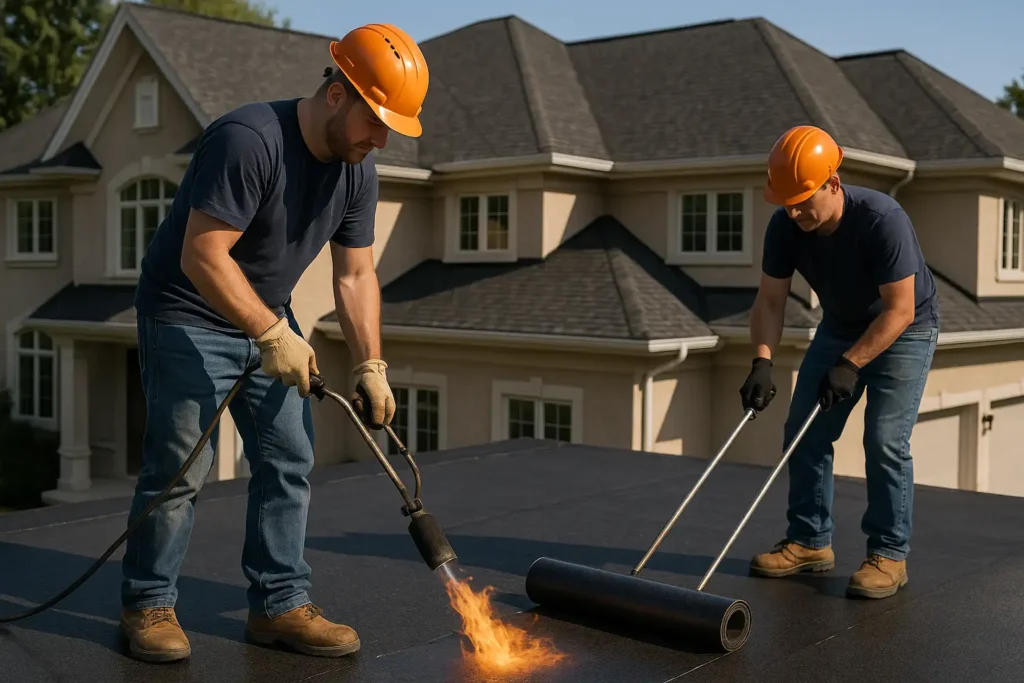Modified Bitumen Roof Repair: Expert Tips Every Homeowner Should Know
Modified bitumen roofing is one of the most durable and flexible flat-roof materials available today. Commonly used on commercial buildings and home additions, it’s made from asphalt blended with rubber modifiers and reinforced with fiberglass or polyester.
This combination creates a waterproof, weather-resistant barrier that can handle East Tennessee’s heat, humidity, and storms. But like all roof systems, even modified bitumen can wear down, crack, or develop leaks over time.
In this guide, we’ll explain how to recognize damage early, explore repair options, and discuss how proper maintenance from Daniel Hood Roofing Systems can extend your roof’s lifespan.

Why Modified Bitumen Roofs Need Regular Maintenance
Unlike sloped shingle roofs, modified bitumen roofs are flat or low-pitched, making them prone to water pooling. Constant sun exposure, heavy rains, and foot traffic can break down the protective top layer. When small cracks or blisters form, they allow water to seep beneath the surface, weakening the adhesive layers and insulation below. Routine maintenance ensures the roof remains watertight and extends its life.
Ignoring these minor issues can cause leaks and interior water damage. Tennessee’s unpredictable weather makes scheduled inspections even more important — especially after storms or freezing temperatures. For comparison, check out our Roofing Damage Repair Guide to understand how extreme weather affects different roof materials.
What Makes Preventive Care So Important
Stops early deterioration: Preventing small cracks from spreading saves you from full-scale roof replacement.
Improves energy efficiency: Well-maintained roofs reduce heat absorption and help with insulation.
Saves money long-term: Regular cleaning and coating cost less than emergency fixes.
Professional maintenance from local roofing contractors keeps your flat roof resilient through Tennessee’s toughest seasons.
Common Signs of Modified Bitumen Roof Damage
Identifying roof problems early can prevent major expenses later. Modified bitumen roofs may look solid on the surface, but even minor wear can compromise their waterproof seal. Watch for visible cracks, air bubbles, or soft spots underfoot.
These often appear after years of exposure to harsh UV rays or standing water. Ignoring these red flags can lead to trapped moisture and insulation damage.
Top Warning Signs to Look Out For
Cracks, splits, or surface blisters
Loose seams where membrane rolls overlap
Soft, spongy areas indicating trapped water
Ponding water lasting over 48 hours
Granule loss or worn texture on the surface
Water stains on ceilings below the roof
If you notice any of these, it’s best to schedule a professional roof inspection right away. Early repairs can prevent costly damage to ceilings, insulation, and walls.
Step-by-Step Process: How Modified Bitumen Roof Repair Works
When it comes to restoring a modified bitumen roof, precision and expertise matter. A certified roofer follows a detailed process to ensure every layer is properly sealed and reinforced. First, they inspect and clean the roof to identify damage.
Then, they prepare the surface, cut out the weakened sections, and apply new membrane patches. Once sealed, a UV-protective topcoat helps reflect sunlight and extend the roof’s life.

Professional Roof Repair Breakdown
Inspection and Cleaning – Clearing debris and checking all seams and flashings.
Surface Preparation – Removing dirt or loose materials for strong adhesion.
Patching or Replacement – Installing new bitumen layers or patch membranes.
Sealing the Repair Zone – Using hot-mop or adhesive sealants to prevent leaks.
Top-Coating – Applying reflective coatings to resist UV rays.
Final Inspection – Testing seams and drains for watertight protection.
Learn how this process differs from urgent storm fixes in our Emergency Roof Repair Guide.
DIY vs. Professional Bitumen Roof Repairs
While homeowners might try quick fixes using roof cement or patches, these are often temporary. Without proper tools, heating equipment, or material knowledge, DIY repairs can make problems worse by trapping moisture or damaging membranes. Modified bitumen requires precision and heat sealing for long-lasting results.
Hiring certified roofers ensures proper bonding, ventilation, and material compatibility — all covered under a valid roof warranty. Professionals also have access to high-quality coatings and safety gear. Attempting a DIY torch-down repair can be risky, so it’s best left to experienced crews.
Why Professional Repairs Are Worth It
Prevents recurring leaks and seam failure
Keeps warranty coverage intact
Ensures correct material match and seal strength
Provides safety during heat application
Qualified teams like Daniel Hood Roofing Systems guarantee long-term solutions, not short-term patches.
Preventing Future Roof Problems
Preventive care is the most cost-effective way to protect a flat roof. Schedule inspections twice a year—typically in spring and fall—to check for signs of wear. Keep drains and scuppers clear so water doesn’t pool. Avoid storing heavy equipment or foot traffic unless absolutely necessary. Re-coating every few years strengthens UV resistance and enhances waterproofing.
Proactive Care Checklist
Clean debris and leaves regularly
Re-coat surface every 3–5 years
Check for ponding water after storms
Trim branches near the roofline
Schedule routine roof cleaning services
Following these steps keeps your roof performing efficiently and prevents problems from Tennessee’s humidity and rain.
Cost and Lifespan of Modified Bitumen Roofs
Repair and maintenance costs depend on roof size, material type, and damage extent. Minor patching is affordable, but large-scale resealing or full replacements can cost more. However, consistent maintenance dramatically increases lifespan—often doubling it. Proper sealing and coating prevent leaks that lead to insulation damage or interior repairs.
Longevity Tips
A well-maintained modified bitumen roof typically lasts 20–25 years, even in East Tennessee’s stormy climate. Applying reflective coatings, clearing drains, and addressing cracks early are key. For a full estimate, visit Roof Repair Estimate to understand costs and available repair options.
Why Choose Daniel Hood Roofing Systems
At Daniel Hood Roofing Systems, we specialize in both residential roof repair and commercial flat roofing. Our trained experts handle modified bitumen, TPO, and EPDM systems with precision. We provide transparent pricing, durable materials, and strong warranties. Every repair includes a detailed inspection to ensure long-term results.
Our Commitment to Quality
We back every project with honest evaluations, upfront pricing, and professional installation. You can count on us for:
Quick response to leaks and storm damage
Clear communication from estimate to completion
Comprehensive warranties for peace of mind
To learn more about our process, explore Tennessee Roof Repair Contractors and see why local homeowners trust our craftsmanship.
Ready to Repair or Restore Your Flat Roof?
Modified bitumen roofing is tough but not indestructible. Cracks, ponding water, and seam wear can sneak up over time. A timely inspection ensures your roof stays strong, watertight, and energy-efficient.
If you’ve noticed warning signs of damage, don’t wait. Contact Daniel Hood Roofing Systems today for a professional inspection and repair plan designed for Tennessee weather.
Your roof protects everything underneath — let’s keep it that way.

